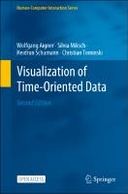Explore

Visualization of Time-Oriented Data
0 Ungluers have
Faved this Work
Login to Fave
This is an open access book. Time is an exceptional dimension with high relevance in medicine, engineering, business, science, biography, history, planning, or project management. Understanding time-oriented data via visual representations enables us to learn from the past in order to predict, plan, and build the future. This second edition builds upon the great success of the first edition. It maintains a brief introduction to visualization and a review of historical time-oriented visual representations. At its core, the book develops a systematic view of the visualization of time-oriented data. Separate chapters discuss interaction techniques and computational methods for supporting the visual data analysis. Many examples and figures illustrate the introduced concepts and techniques. So, what is new for the second edition? First of all, the second edition is now published as an open-access book so that anyone interested in the visualization of time and time-oriented data can read it. Second, the entire content has been revised and expanded to represent state-of-the-art knowledge. The chapter on interaction support now includes advanced methods for interacting with visual representations of time-oriented data. The second edition also covers the topics of data quality as well as segmentation and labeling. The comprehensive survey of classic and contemporary visualization techniques now provides more than 150 self-contained descriptions accompanied by illustrations and corresponding references. A completely new chapter describes how the structured survey can be used for the guided selection of suitable visualization techniques. For the second edition, our TimeViz Browser, the digital pendant to the survey of visualization techniques, received a major upgrade. It includes the same set of techniques as the book, but comes with additional filter and search facilities allowing scientists and practitioners to find exactly the solutions they are interested in. ; Time is an exceptional data dimension due to its importance and unique influence. This implies that special methods are needed for dealing with time in data sets in order to take advantage of these specifics. Visual methods are a key part of this tool set allowing for presentation, analysis, and exploration of temporal data sets. Visualisation of Time-Oriented Data provides an overview of the field of visualisation techniques for time-oriented data, but even more importantly analyses the specifics and similarities of the investigated techniques in order to identify clusters for structuring and making the field manageable. It also analyses the techniqes uniformly along different sets of attributes making it easy to grasp their main characteristics and support researchers as well as developers in selecting appropriate techniques for their demands. The theoretic foundations of visualization itself are also discussed, the data dimension time, tasks related to time-oriented data, possible mappings of time, various examples of early (pre-computer age) representation techniques, and a conceptual framework for visually analyzing time-oriented data.
This book is included in DOAB.
Why read this book? Have your say.
You must be logged in to comment.
Rights Information
Are you the author or publisher of this work? If so, you can claim it as yours by registering as an Unglue.it rights holder.Downloads
This work has been downloaded 72 times via unglue.it ebook links.
- 72 - pdf (CC BY) at Unglue.it.
Keywords
- Combinatorics & graph theory
- Computer science
- Computer-Generated Visual Representations
- Computing & information technology
- Human-computer interaction
- Mathematics
- Mathematics & science
- thema EDItEUR::P Mathematics and Science::PB Mathematics::PBV Combinatorics and graph theory
- thema EDItEUR::U Computing and Information Technology::UY Computer science::UYZ Human–computer interaction::UYZG User interface design and usability
- Time-Oriented Data
- User interface design & usability
- Visual analytics
- Visualization
Links
DOI: 10.1007/978-1-4471-7527-8Editions

